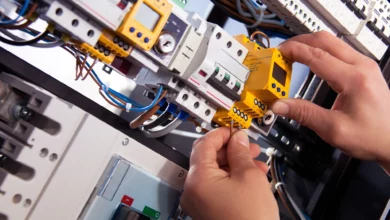Butterfly Valve vs. Ball Valve: Key Differences for Industrial Applications

If you’re looking to install your industrial piping that is going to flow efficiently and reliably, you need to know all of your options.
The two most common types of valves are rotary valves, also known as ball valves, and butterfly valves.
Knowing the pros and cons of butterfly valve vs ball valve can help you make an informed decision on the type to use in your industrial piping.
While they may look similar, they are quite different. Depending on your application and flow needs, one may be better than the other.
Design and Operation
Butterfly valves work best in applications with clean and milder fluids, such as water, because the disc design is more vulnerable to fouling. This also generally has a reduced number of components, making them an easy and cost-effective option.
Ball valves are generally better for handling thicker, harsher fluids, such as oil, gas, and chemicals, because the ball is more resistant to wear. There are much more complex and can require increased maintenance.
Flow Regulation
Butterfly valves feature a disk-shaped flap, which is located within the pipe. This flap is attached to a rod that is connected to an actuator which is used to control the valve’s opening and closing.
Ball valves include a spherical seat with a hole in the center. A ball rotating inside the pipe is used to open and close the valve. Butterflies offer quick operation and can be used when small, precise control over the flow is needed, whereas ball valves tend to be slower to operate and usually require more complex systems due to their larger structure.
Pressure Drop
Butterfly valves have a distinct advantage in that they create a minimal pressure drop – usually lower than 5%. On the other hand, Ball Valves can cause a higher loss in pressure of up to 10%. In addition, this commonly requires lower pressure to open and close compared to ball valves.
The main benefit of butterfly valves is their fast response time, while ball valves are more reliable and often last for longer. There are easier to install compared to ball valves and are more reliable when used in systems with short, straight piping.
Space and Weight
Butterfly valves have become increasingly popular due to their compact dimensions and lighter weight when compared to ball valves. This makes butterfly valves a great choice in applications where space and weight are limited. Furthermore, they are usually less expensive than ball valves since they require fewer parts.
On the other hand, ball valves are better at regulating flow, and their tight shutoff makes them ideal for precision control. Furthermore, they can be used in higher-pressure systems than butterfly valves.
Sealing Mechanism
The sealing mechanism of a Butterfly valve is accomplished when the disc is perpendicular to the flow of the media, while a Ball valve requires high line pressure to achieve a secure seal. Butterfly valves provide a relatively soft seal which may be prone to leakage, while Ball valves have excellent seating performance with limited leakage.
The right valve selection should be selected according to the expected pressure rating, the temperature of the media, and the flow fluid control required.
Maintenance and Repairs
Butterfly valves are generally considered more durable than ball valves, and they rarely need repair or replacement. Because they have fewer moving parts than ball valves, their functionality is not as affected by dirt and debris buildup. They require less frequent maintenance than ball valves in most industrial applications.
On the other hand, need to be serviced periodically to ensure proper functionality. Dirty and debris clogging can affect the performance of ball valves and cause them to malfunction, making necessary frequent repairs.
Cost
Butterfly valves are generally more expensive than ball valves due to their complex structures and use of superior materials. Although the initial investment in butterfly valves is higher, they are often more reliable and require less maintenance, resulting in a lower total cost of ownership in the long run.
Ball valves, on the other hand, have fewer moving parts and are therefore cheaper up-front but need greater attention for maintenance as the components tend to wear quickly. Depending on the individual application, either option may be cost-effective and provide optimal lifecycle performance.
Temperature and Pressure Ratings
Butterfly valves are generally preferred when higher pressures are needed, as they typically have higher maximum pressure ratings than ball valves. However, industrial ball valves have higher temperature ratings, making them a better choice for hot fluids or applications with higher thermal loads.
Butterfly valves are not able to handle high-temperature extremes and can also have a head loss due to the large disc area used to open or close the flow. Ball valves have a smaller disc area and are able to open and close the flow quickly, making them the preferred choice for applications with medium to high pressure.
Cavitation and Erosion
Butterfly valves have a more efficient flow rate due to their curved edged, and thus their design is better suited for high-velocity applications that could cause cavitation and erosion. Ball valves, on the other hand, are more commonly used in low or medium-velocity applications without risk of cavitation.
Butterfly valves can offer more precise control for modulating applications, whereas ball valves are better suited for more traditional on/ off systems.
Application Suitability
A butterfly valve is generally less expensive to purchase and install than a ball valve. However, the Ball is much more suitable for valve applications where the most vital criteria is a tight shutoff and where valve productivity under pressure is essential. In addition, a ball valve is less likely to experience sticking due to valve seat design and the ability to automatically self-align, making them ideal in the most demanding applications.
Butterfly Valve vs Ball Valve: Key Differences for Industrial Applications
The butterfly valve vs ball valve has distinct features; however, both are effective tools for industrial applications. The butterfly valve offers a 90-degree turn with little obstruction, while the ball valve offers a complete opening and closing.
To ensure the best valve selection, it is important to understand the particular benefits and drawbacks of each application. Consult with a valve expert who can guide you on the most appropriate solution for your industrial application.
Was this article helpful? Bookmark our site for more valuable and informative insights.




